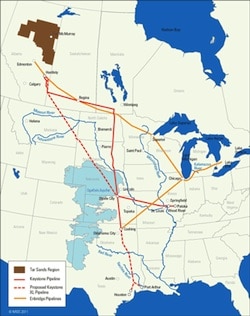According to the NRDC, the proposed $13 billion Keystone XL tar sands pipeline would not be able to detect “pinhole leaks” in the pipeline that release fewer than 700,000 gallons of tar sands oil a day. The company proposing to build the pipeline, TransCanada, has admitted that their leak detection system be unable to detect such leaks in real-time, meaning a small but powerful leak could continue for weeks before the company became aware of the problem.
What’s worse is that the proposed pipeline would run directly over the Ogallala aquifer, one of the largest underwater freshwater reserves in America, meaning that a pinhole leak could poison millions of gallons of water in an area that cannot be easily accessed, and that provides drinking water to millions of Americans.
From the NRDC:
TransCanada has admitted that Keystone XL’s real time leak detection system will not detect pinhole leaks and can’t be relied upon to detect leaks smaller than about 700,000 gallons a day. Despite this significant shortcoming, the only route that the State Department has seriously considered for Keystone XL would take it through the heart of the Ogallala Aquifer, our nation’s largest underground water source. Enbridge’s recent 63,000 gallon spill on its Norman Wells pipeline in Canada provides an indication of the types of leaks that can go undetected for weeks on pipelines like Keystone XL that rely on conventional leak detection systems to identify leaks. What is really surprising about the Enbridge spill is that 63,000 gallons of oil leaked from a hole in the pipeline that was “about the size of a pinhole.” The Enbridge spill shows what a big deal a small leak can be.
A spill on Keystone XL in the Ogallala Aquifer would be far worse. Keystone XL would be an 830,000 bpd tar sands pipeline placed underground, actually running through the Ogallala Aquifer itself in many places. The Supplemental Draft Environmental Impact Statement (SDEIS) for Keystone XL states that the water conductivity – or the rate that water moves through the soil – in the Ogallala Aquifer can be as high as one hundred feet per day. This proves a substantial point, as the SDEIS concedes Keystone XL does not have the technology to detect a single leak that is less than 1.5-2% of the pipeline’s flow-rate. It also mentions that a pinhole leak could go on for weeks before discovery.
Despite the fact that the automated system will allow leaks to go unnoticed, TransCanada has stated that it will not be sending employees to walk the pipeline to look for leaks. Instead, the company will send small aircraft to view the pipeline from above every 3 weeks, and ground patrol will only occur when a leak is confirmed. In the time between flyovers, a pinhole leak at a rate of 700,000 gallons a day could release more than 14.7 million gallons of tar sands oil into the environment before anyone noticed.
As DeSmogBlog’s Emma Pullman noted recently, TransCanada’s Keystone I pipeline was shut down for days by the EPA due to a high number of leaks – the Keystone I pipeline is currently averaging about 1 leak per month in its first year of operation. If their safety record for this pipeline is any indication, the Keystone XL could be riddled with just as many, if not more, problems.
The EPA recently faulted the State Department’s “insufficient” analysis of the Keystone XL pipeline in its Supplemental Draft Environmental Impact Statement (SDEIS). You can find more information on that assessment here.
Subscribe to our newsletter
Stay up to date with DeSmog news and alerts







